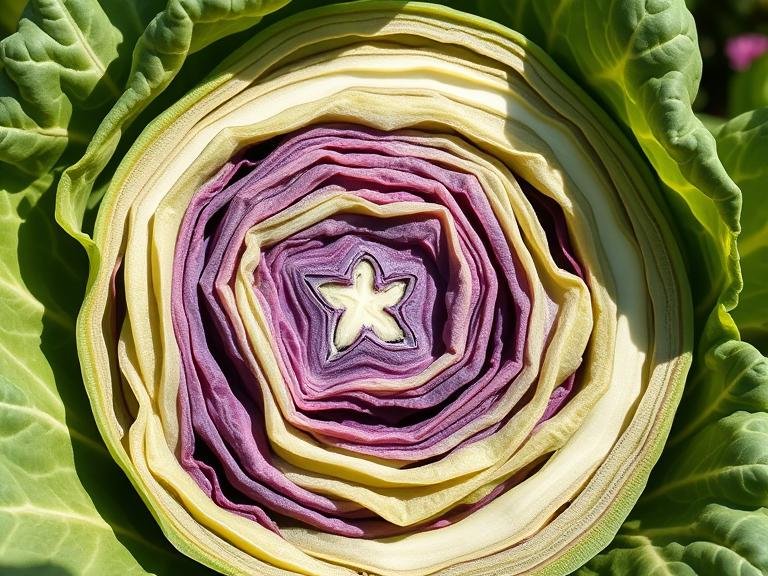In the world of vegetable gardening, few sights are as reliably verdant as a row of thriving cabbage plants, their layers of leaves tightly wrapped into crisp, green orbs. So, it can be surprising, and even concerning, for a gardener to peel back the outer leaves and discover a striking splash of purple, violet, or even a deep burgundy hue. The immediate question arises: is this a sign of disease, a nutrient deficiency, or something else entirely? The phenomenon of cabbage leaves going purple is a fascinating interplay of plant genetics, environmental stress, and natural biochemistry. Far from being a cause for alarm in most cases, this color change is the plant’s own eloquent response to its growing conditions. This article delves into the science behind the purple pigment, explores the common triggers, and helps you determine when it’s a natural occurrence and when it might signal a problem.
Table of Contents
The Science of the Color: Anthocyanins at Work
To understand why cabbage leaves turn purple, we must first look at the source of the color: a group of pigments called anthocyanins. These are water-soluble compounds belonging to a larger class of plant chemicals known as flavonoids. Anthocyanins are responsible for the brilliant reds, purples, and blues in many fruits, vegetables, and flowers—think blueberries, red apples, purple grapes, and, of course, red cabbage.
In a standard green cabbage, the dominant pigment is chlorophyll, which is essential for photosynthesis and gives the plant its characteristic green color. The green of chlorophyll can mask the presence of anthocyanins. However, under certain conditions, the production of anthocyanins can be boosted or the chlorophyll can break down, allowing the purple pigments to become visible.
Plants produce anthocyanins for several important reasons, often acting as a natural sunscreen. They help protect plant tissues from damage caused by excessive ultraviolet (UV) light. They also serve as powerful antioxidants, neutralizing harmful molecules called free radicals that are generated when the plant is under stress. Therefore, the appearance of purple on cabbage leaves is frequently the plant’s defensive mechanism kicking into high gear.
Common Triggers for the Purple Transformation
The development of purple coloration is typically a symptom, not a disease itself. It indicates that the plant is experiencing some form of environmental stress. Here are the most common triggers:
1. Temperature Fluctuations and Cold Stress
This is the most frequent cause of purple cabbage leaves, especially in the spring and fall. Cabbages are cool-weather crops, but they have their limits. When temperatures drop suddenly or remain consistently low (typically below 50°F or 10°C), the plant’s metabolism changes.
- The Reaction: Cold temperatures can inhibit the plant’s ability to produce and retain chlorophyll. Simultaneously, the plant increases anthocyanin production as a protective measure. The anthocyanins help to safeguard the leaf cells from photo-oxidation—damage caused by light when the plant’s photosynthetic processes are slowed by the cold. The result is a beautiful, often harmless, purpling of the outer leaves or even the veins of the inner leaves.
2. Phosphorus Deficiency
In the gardener’s checklist of potential issues, a lack of phosphorus is a prime suspect when leaves turn purple. Phosphorus is a vital macronutrient crucial for energy transfer within the plant, supporting root development, and overall growth.
- Identifying the Cause: While cold stress can cause purpling regardless of soil nutrients, a phosphorus deficiency will manifest similarly. How can you tell the difference? A phosphorus-related purpling is often accompanied by other symptoms, such as stunted growth and leaves that may appear dull, dark green, or even bluish-green before the purple tones emerge. The purpling usually starts on the older, lower leaves and moves upward. If the soil is cold, the plant may also struggle to absorb phosphorus, even if it’s present, creating a combination of both factors.
3. Intense Sunlight (High Light Exposure)
As mentioned, anthocyanins act as a sunscreen. When cabbage plants are exposed to unusually intense or prolonged direct sunlight, particularly when combined with other stresses like drought or cool temperatures, they may produce more purple pigment. This is the plant’s way of applying its own SPF to prevent cellular damage from UV rays.
4. Genetic Predisposition
It’s important to remember that some cabbage varieties are supposed to be purple! Red cabbage cultivars are specifically bred to produce high levels of anthocyanins throughout their development. What you might be seeing in a supposedly green cabbage could be a slight genetic variation or a throwback trait expressing itself under stress.
Is Purple Cabbage Safe to Eat?
This is the most pressing question for any gardener who has invested time and effort into growing their crops. The answer is a resounding yes. Cabbage with purple-tinted leaves is perfectly safe to consume. The anthocyanins responsible for the color are not only harmless but are actually beneficial compounds known for their antioxidant properties in the human diet. The taste and texture of the cabbage are generally unaffected. You might even be giving yourself an extra nutritional boost!
When Should You Be Concerned?
While purpling is usually benign, it’s wise to be observant. The color change itself is not a problem, but the underlying cause might need addressing if it’s related to a significant nutrient deficiency that could impact the plant’s health and yield.
- Assessing for Phosphorus Deficiency: If you suspect a lack of phosphorus is the culprit, conduct a soil test. This is the only reliable way to confirm a nutrient imbalance. If the test confirms a deficiency, you can amend the soil with a phosphorus-rich organic fertilizer, such as bone meal or rock phosphate, according to the package instructions. Remember, correcting the soil pH (aiming for a slightly acidic pH of 6.0 to 7.0) is also critical, as phosphorus availability is highly dependent on it.
- Ruling Out Other Issues: If the purpling is accompanied by wilting, soft rot, holes in the leaves from pests, or black spots, these are signs of separate issues like disease or insect infestation that need to be addressed independently. The purpling in these cases might be a secondary symptom of a plant under severe duress.
Preventative Measures for a Healthy, Green Harvest
If you wish to minimize the chances of your green cabbages turning purple, focus on providing optimal and consistent growing conditions.
- Timely Planting: Plant your cabbages so that they mature during the cool, but not cold, seasons of the year. Avoid having young plants exposed to early spring frosts or maturing heads exposed to hard autumn freezes.
- Soil Health is Key: Before planting, enrich your soil with well-rotted compost. Conduct a soil test to ensure a proper balance of nutrients, including phosphorus, and adjust the pH if necessary.
- Consistent Watering: Maintain even soil moisture. Drought stress can exacerbate other issues and trigger anthocyanin production. Using mulch around the plants can help regulate soil temperature and retain moisture.
- Appreciate the Uniqueness: Sometimes, despite your best efforts, a cold snap will happen. In these cases, view the purple hue as a badge of honor—a sign that your plant is resilient and protecting itself from the elements.
Informational FAQs
Q1: My entire cabbage head is light purple instead of green. Is it still edible?
A: Absolutely. It is likely a case of significant anthocyanin production due to prolonged exposure to cool weather or strong sunlight. It is safe to eat and may even have a slightly higher antioxidant content.
Q2: Can I still make coleslaw with slightly purple cabbage? Will it turn pink?
A: Yes, you can. The anthocyanins are water-soluble and can leach out, potentially turning the dressing a light pink color, especially if it’s acidic (like a vinaigrette). This is perfectly normal and does not affect safety.
Q3: I planted a red cabbage, but it’s not very purple. Why?
A: Environmental factors work both ways. For red cabbage to develop its deepest color, it needs good sunlight. If it’s grown in too much shade, the color may be less intense. Furthermore, extreme heat can sometimes inhibit color development.
Q4: Is there a difference in taste between green cabbage and cabbage that has turned purple?
A: Generally, the taste difference is negligible. Some people report a very slightly stronger or “earthier” flavor in the purple portions, but it is often unnoticeable, especially when cooked or mixed with other ingredients.
Q5: Should I remove the purple leaves from the plant?
A: No, there is no need to remove them. These leaves are still functional, performing photosynthesis and protecting the inner head. Removing them unnecessarily can open wounds that might allow pests or diseases to enter.


